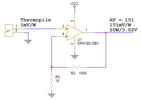I have a thermal power detector from Thorlabs TD15A and planning on using it to measure power output from a laser. The laser has a power output range from 5mW to 20W. I was wondering if anyone here has experience with such a circuit design. I'm planning on creating a simple op-amp amplifier with a gain of about 100 and feed the analog signal into a micro-controller. If anyone has sample circuit that I can build upon or other reference material it will be appreciated.


